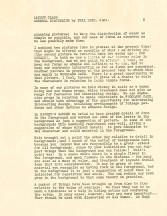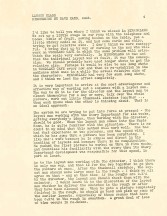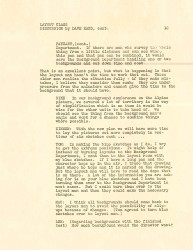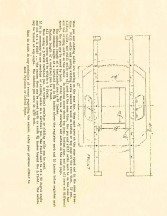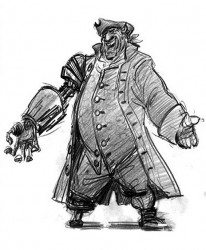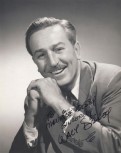Monthly ArchiveOctober 2006
Commentary &Daily post 21 Oct 2006 08:52 am
Conversation
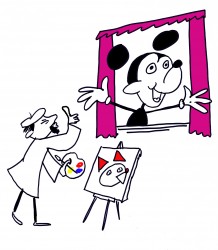 - Let’s see.
- Let’s see.
. First there was an interview with Patrick Smith on AWN.
. Then Amid Amidi commented on Cartoon Brew.
. Then David Levy wrote an editorial on the ASIFA-East newsletter/site.
. Then I had a couple of comments on David‘s comments.
. Then Amid was back to comment on David,
. Stephen Worth had a lot to say on my blog.
. Mark Mayerson commented on his site.
. Amid posted a number of the emails sent to him and led to sites & blogs that commented.
- And he continues to post more and more input on the subject.
Phew!
All that being said; I think there was a lot of good conversation on the subject. I was particularly taken by what Chris Robinson had to say on Cartoon Brew:
- This obsession animators have with getting a tv series drives me crazy. Why is it your goal to have a tv series? Who said animation has to have regular characters, actors, and narratives? Your mommy? I see how it influences and ruins so many short films we receive at the OIAF because these works have not one ounce of personality, they are projects made to try to appease the desires/wants/needs of what they think SOMEONE ELSE wants…they are not making art, they are seeking markets to fit into.
This is a very high-minded response to the entire question of pitching vs making an independent film, but it’s the heart of the matter. You’re doing one or the other, but not both. Series samples are just that – samples. They’re not EVER fully developed. The maxim goes that a series doesn’t develop fully until the 2nd or 3rd year. An Independent short is all there is. (Usually. I can only think of one example of a series growing out of a truly Independent short – Bob’s Birthday. (I’ve discounted the Christmas card from the South Park people.) The only example I can think of a pilot acting as a stand-alone film is The Chicken From Outer Space.)
In essence, I think, Chris Robinson is right: Art is Art (a high & mighty term for most animated films), and commerce is commerce.
 – Today, at Noon, a series of current family films will show at the Museum of Modern Art. Admission is free on a first come first serve basis. They have one of these each month. There’s a particularly interesting screening coming Dec. 9th.
– Today, at Noon, a series of current family films will show at the Museum of Modern Art. Admission is free on a first come first serve basis. They have one of these each month. There’s a particularly interesting screening coming Dec. 9th.
Josh Staub‘s cg film, The Mantis Parable, is among those featured today.
- Tomorrow, Sunday Oct.22nd at 2pm, the Museum of Modern Art will screen Nina Paley‘s short film, The Stork.
Action Analysis &Animation Artifacts 20 Oct 2006 09:30 am
Phil Dike LO Lecture
- As I noted yesterday, - Hans Perk on his site, A Film LA, has posted the Ken Andersen LayOut Training Course from the Disney studio Nov, 1936. I’ve posted two of these – Part I and Part III.
I have a fourth lecture that Phil Dike gave on May, 1936; it was called a “General Discussion”. Unfortunately, two of its pages were copied off kilter, so more than half of pgs. 8 & 9 are missing. Since there’s still good information in there, I’ve decided to post it anyway. I’ve had to clean it up a bit to make a couple of pages legible.It follows:
Animation 19 Oct 2006 07:39 am
The Other Miyazaki
 - Charles Solomon has written a very interesting article for the NYTimes on Goro Miyazaki‘s animated feature, Tales From Earthsea. Of course, Mr. Miyazaki is the son of the other Miyazaki, Hayao. The article discusses the problems of being the son of someone so famous and the expectant comparisons people have made about him and his work. Many of the critics seem to be negative. (Here’s the Variety review.)
- Charles Solomon has written a very interesting article for the NYTimes on Goro Miyazaki‘s animated feature, Tales From Earthsea. Of course, Mr. Miyazaki is the son of the other Miyazaki, Hayao. The article discusses the problems of being the son of someone so famous and the expectant comparisons people have made about him and his work. Many of the critics seem to be negative. (Here’s the Variety review.)
The film has done well in Japan (though not quite up to the results of his father’s films) and has received some backlash from Ursula K. LeGuin whose Earthsea books were adapted for the film.
The U.S. release of Goro Miyazaki’s film is being held up by the Sci-Fi Network who owns the rights until 2009. They did a poor live action film which is available in dvd.
For some small information regarding Hayao Miyazaki‘s next feature go here or here.
Visit Daniel Thomas MacInnes‘ site Conversations on Ghibli.
.
- Hans Perk on his site, A Film LA, has posted the Ken Andersen LayOut Training Course from the Disney studio Nov, 1936. I’ve posted two of these – Part I and Part III. This is the one, Part II, of the series that I was missing. I do have a fourth (actually the first one) that Phil Dike gave on May, 1936, but two of it’s pages were copied off kilter. I’ll post that soon.
.
- Posting that caricature of the folks in my studio in 1992 gave me the idea that I should be posting links to blogs and sites that some of my ex-employees have. Here are a couple of them:
Stephen MacQuignon has always been interested in fantasy art, and his site reflects this -Stephen MacQuignon.
Jason McDonald has two sites – My Living Dead Girl and Jason McDonald Design.
Sophie Kittredge has a beautiful array of illustrations and maps – Craven Design/Sophie Kittredge.
Robert Marianetti and his partner David Wachtenheim have a studio site that is under construction – wmanimation.com
Doug Compton, animator extraordinaire, has his site – Karmatoons.
Animation Artifacts 17 Oct 2006 12:22 pm
Iwerks’ work
- From my earliest days, as soon as I’d learned who he was, I was a fan of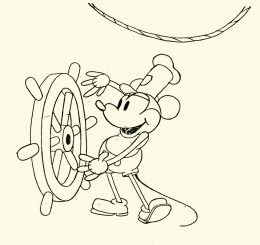 Ub Iwerks.
Ub Iwerks.
I began to wonder if it was just the publicity and myth of Iwerks which had followed with him all these years. We read about all those 1930′s East coast animators moving to the West, not to work for Disney but to seek out Iwerks – it was well known that he was the “true artist” behind those Disney shorts.
With Bob Thomas’ 1958 book, The Art of Animation, I read, for the first time, about Iwerks and his importance. Only recently did I begin to wonder how responsible Iwerks actually was to Disney’s success. Was this just that myth being carried over the years? Or was he brilliant?
 A quick look at the animation done at the time and we see some basics not yet developed.
A quick look at the animation done at the time and we see some basics not yet developed.
There weren’t many stories written before Disney, so animators divided up their pictures. For example: They’d decide to do a film where Mutt & Jeff would go to Hawaii. One animator would start on the beach and end with them on surfboards. The animator would make it up as he went along until he turned out the required footage – maybe 2 minutes of work. The next animator would pick up Mutt & Jeff on surfboards and take them to being washed up on the beach, etc.
 Obviously, the lead animator doled out rudimentary plot points, but a lot was left to the individual animator. Look at the book, Walt In Wonderland by Russell Merritt & J.B. Kaufman to see how Disney started developing stories during this period.
Obviously, the lead animator doled out rudimentary plot points, but a lot was left to the individual animator. Look at the book, Walt In Wonderland by Russell Merritt & J.B. Kaufman to see how Disney started developing stories during this period.
The same was true for animation techniques and methods. Animation burst out of its seams with the creation of Mickey Mouse. Disney had initiated a lot of ground work, but the medium really started growing with the enormous success of Steamboat Willie. Iwerks led the way, not only by the amount of work he did but the quality.
 Take a look at these five Iwerks drawings from that short.
Take a look at these five Iwerks drawings from that short.
One of the first lessons an inbetweener learns is that a face turn shouldn’t have a direct middle in it. The middle drawing (#3 here) shouldn’t be straight on; it should favor, slightly, one side or the other.
Despite the simple drawings of Mickey, Ub Iwerks seemed to understand this instinctively. He didn’t really get lessons from anyone. As a matter of fact, he was creating the rules. This comes close to being straight on, but the mouth gives it away. The face is facing screen left.
 Another simple inbetween lesson is to offset the inbetween (usually an animator or good assistant will set this up for the inbetweener.)
Another simple inbetween lesson is to offset the inbetween (usually an animator or good assistant will set this up for the inbetweener.)
Here Mickey is standing upright on #1 and he’s upright on #5. Drawing #3 has him with knees bent, beating in tempo to the sound. Even though this is from the first sound cartoon, done in 1928, the offset rule is in effect.
I think it’s pretty clear that some sophistication has entered the animation that Iwerks was drawing. This same sophistication isn’t in other animator’s work.
(Click any image to enlarge.)
Add to this the fact that Iwerks was probably the fastest producing animator, and you probably have good reason for knowing he was the genius behind Disney.
This, of course, didn’t remain that way. After Iwerks left, leaving behind enough animators trained by him, their work developed exponentially. Better artists were entering the studio and bringing their talents to the work, and they started making a serious attempt to improve the work.
Iwerks stopped animating and stopped trying to improve the character animation. Instead, he tried to improve the camera – actually developing the mulitplane camera in his own studio. Animation, under Iwerks, didn’t develop.
The book by John Kenworthy, The Hand Behind The Mouse, gives some solid information that wasn’t previously published and puts a lot of material into perspective. Someday we’ll get another voice on this great subject with more critical insight.
Animation 17 Oct 2006 08:38 am
Plymptonia & Levymania
 Hair High, Bill Plympton‘s most recent animated feature finally opens in NYC on Wednesday. It runs from Oct 18 through Oct 25 at the Two Boots Pioneer theater .
Hair High, Bill Plympton‘s most recent animated feature finally opens in NYC on Wednesday. It runs from Oct 18 through Oct 25 at the Two Boots Pioneer theater .
Plympton will make personal appearances at the theater; every guest at the premiere will receive a drawing from Bill.
Cast members and other guests (including the “Krazy Kock” chicken mascot) will appear at the premiere.
(Read the NYTimes review.)
Hair High is the legend of a 1950′s teenage couple murdered on prom night who return as undead skeletons one year later for revenge. The film’s a romantic comedy with a zombie-horror twist. NY’s own independent animator, Bill Plympton. self-financed the film, co-produced by his friend and distant cousin, actress Martha Plimpton.
Hair High features an all-star cast including the voice talents of Dermot Mulroney, Sarah Silverman, David Carradine, Keith Carradine, Beverly D’Angelo, Martha Plimpton, Eric Gilliland, Ed Begley Jr., Michael Showalter, Zak Orth, Justin Long, Craig Bierko, Tom Noonan and animators Matt Groening and Don Hertzfeldt.
Also included in the screening will be Bill Plympton’s Oscar-nominated animated short Guard Dog, and its sequel, Guide Dog.
Pioneer Two Boots Theater
155 East 3rd St. (between Ave. A + B)
New York NY 10019
Showtimes: 212-591-0434
Advance Tickets: www.twoboots.com/pioneer/hairhigh.htm
For more information about the film:
www.hairhigh.com or www.plymptoons.com
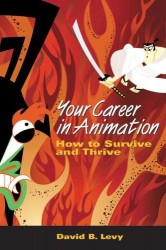 – On the ASIFA-East newsletter & site, ASIFA-East President, David Levy comments on making Independent short films as opposed to sample/pilots for pitches you want to make.
– On the ASIFA-East newsletter & site, ASIFA-East President, David Levy comments on making Independent short films as opposed to sample/pilots for pitches you want to make.
This grew out of Amid Amidi‘s comments on Cartoon Brew regarding a statement Pat had made on AWN.
It takes three sites to track it all down, but it’s interesting to follow the thread. To read it all chronologically go: here, then here, then here.
- Speaking of Dave Levy, his book, Your Career In Animation continues to garner positive reviews. Everyone from Michael Barrier (06/29/06) to Jerry Beck to Tom Sito has said nice things about it.
The book is a good, easy read with much to offer anyone interestedkin animation.
Speaking of ASIFA-East, they have an open screening scheduled for Thursday night at 7PM at the School of Visual Arts.209 East 23rd Street, Rm. 502 Bet. 2nd & 3rd Ave
and then on Halloween (Oct. 31st) they show the The Best of British Animation Awards. Among those shown will be Rabbit which won the top short film prize at Annecy.
Same place; same time; different day. Come in costume.
Daily post 16 Oct 2006 07:51 am
Links d’Animation
- Here are a couple of animation links I came across:
. There’s a web site devoted to the work of Glen Keane that includes many pencil tests from his scenes as well as many drawings and model sheets.
. An animated film produced for the Vatican tells the life story of Pope John Paul II. Here’s the Catholic.net version of the story.
It was produced by the Spanish animation company, Cavin Cooper Productions.
José Luis López-Guardia was the producer/director.
To see the trailer for the film go here.
It isn’t Pope John Paul on the left but “Silver” from Treasure Planet. (Click to enlarge.)
. There’s a direct link to some of the images at the Disney exhibit in Paris at the Galeries Nationales du Grand Palais. This looks to be an interesting show; one presumes since a lot of the influences are also apparently on display.
The 360 page catalogue is in French and on sale on line here.
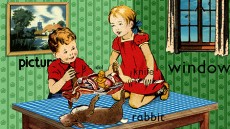 . To get as far away from Disney as possible, there’s an extended article about Run Wracke and the peculiarly interesting and unsettling film, Rabbit. It’s an unsettling reworking of the Dick and Jane readers as the two kids display lots of greed and maliciousnous in the
. To get as far away from Disney as possible, there’s an extended article about Run Wracke and the peculiarly interesting and unsettling film, Rabbit. It’s an unsettling reworking of the Dick and Jane readers as the two kids display lots of greed and maliciousnous in the
8½ min short.
A clip from the film’s opening can be seen on the “Recent Work” section of Run Wracke‘s site.
Firoz (in current comments) left this link to the entire film:
Photos 15 Oct 2006 08:50 am
Studio Sunday
- Since I have a lot of photos – I mean a lot of photos of my various crews over the years, I thought it’d be fun to post some of these and will use Sunday as the best day for it.
To break the habit before I start, I’m putting up a caricature of the staff done in 1992 by a fabulous artist and animator who worked for us. Rodolfo Damaggio was someone who came fully formed from Brazil. I gave him his first job in the US, and was glad that I did. He started as an assistant and it took him two days to become an animator. He was a dynamo to work with. He’s moved out of animation onto comic books (Superman, Green Arrow et al) and storyboards for feature films (Jurassic Park trilogy, Star Wars III, currently Iron Man).
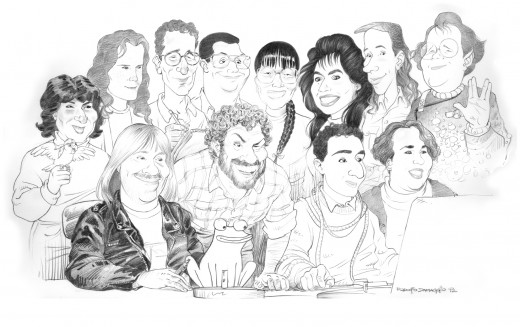
(Click on image to enlarge.) A better crew you won’t find - at the steenbeck.
Pictured: (back row standing) Sue Perotto (animator), Elizabeth Seidman (production coordinator), Ray Kosarin (animator), Stephen Gambello (colorist/runner), Masako Kanayama (designer/Production Manager), Marilyn Rosado (studio manager), Rodolfo Damaggio (animator), Jason McDonald (colorist/storyboards/designer).
(Front row seated) Stephen MacQuignon (colorist), George (Dancing Frog), me, Ed Askinazi (editor), Denise Gonzalez (assistant/publicity).
Not pictured: Christine O’Neill (colorist, at the time) who doesn’t like her picture taken and worked out of the studio at the time. It always has bothered me that she wasn’t in there.
Animation Artifacts 14 Oct 2006 08:23 am
More Corny
- My recent posting of art from Raggedy Ann & Andy prompted John Celestri to send me this clipping from the Cincinnati Enquirer re the kidnapping of Ann & Andy.
- Here are some more of Corny Cole‘s story board drawings from Raggedy Ann & Andy.
This first Layout marks the introduction of Raggedy Andy. He’s under the box. This drawing gives you a good idea of the detail Corny put into every drawing.

(Click on any image to enlarge.)
The following images come from the first shots of the Pirate Captain. He espys the new doll, Babette, and falls madly in love.
The first four stills are 8.5×14 copies of the storyboard; the remainder come from the director’s workbook. They’re all sequential.

I think the parrot, which was added in pencil, is the work of Asst. Director, Cosmo Anzilotti. The bird just shows up later, so Cosmo probably tried to give him some business.
It’s here that the Pirate goes into his song (everybody sings in this film) and concocts his plot to kidnap the French doll.
Daily post &Fleischer 13 Oct 2006 09:16 am
Friday the 13th
 – I’d like to remind you that Mike Dobbs is continuing to post his biography of the Fleischer brothers as it’s written. You can find this on his site, Made of Pen and Ink.
– I’d like to remind you that Mike Dobbs is continuing to post his biography of the Fleischer brothers as it’s written. You can find this on his site, Made of Pen and Ink.
The former editor of Animato and Animation Planet posted his Introduction several weeks back and has just added Chapter One to the site.
Since there hasn’t been much done exclusively about this very prolific studio, it’ll be welcome. I have Out of the Inkwell, Richard Fleischer’s biography of his father, Max. I also have Leslie Carbaga’s fanzine of a book, The Fleischer Story.
Neither of these books is very critical, so it’ll be interesting to see how Mike Dobbs’ work will grow. With all the work he’s done over the years, it certainly should be the authoritative version. Check it out.
- Jenny Lerew, on her site Blackwing Diaries, has posted an excellent comment on women at the Disney studios. This is something of a theme she’s been developing, and it’s wonderful. I look forward to everything she has to say.
She uses this posting as a way of talking about the “See Jane/Union “Where The Girls Aren’t” panel which she’d attended. Events like this, as described by Jenny, make me momentarily sorry I don’t live in LA.
- If you haven’t found it yet, Tony White has set up the Animaticus Foundation and a new site to go with it. It’s apparently dedicated to 2D animation and is a good start with plenty to view and a promising forum on which to chat and leave comments. (Thanks to Dave Nethery for highlighting on his site.)
- Today, the NYTimes has a review of the exhibit, Master of American Comics, currently on view at the Jewish Museum in NY and the Newark Museum. A show worth visiting.
 - Friday the 13th, and it’s appropriate for me to have received my weekly notice from Jason McDonald re the latest edition of his online comic strip, My Living Dead Girl.
- Friday the 13th, and it’s appropriate for me to have received my weekly notice from Jason McDonald re the latest edition of his online comic strip, My Living Dead Girl.
This has to be the first retro-minimalist comic. Jason has always been a fabulous graphic artist, and he’s letting it all loose in this strip.
Unfortunately, you’ve missed quite a few episodes of the strip, but if you go back into his archives, you can catch up. He also has a number of other things to check out including merchandise for sale.
Jason has done quite a bit of art for my studio over the years; some of it appears on his main site, Jason McDonald Design (also worth checking out).
In the next week, I hope to highlight some of Jason’s work which he did for my studio.
(Images enlarge marginally when clicked,)
Animation &Animation Artifacts &Richard Williams 12 Oct 2006 07:54 am
Andy & Corny
- Seeing the models David Nethery posted on his site, You’re A Gazelle, in his comments on Tissa David‘s work from Raggedy Ann, started me thinking about the Dick Williams‘ film. As I noted, yesterday, I have quite a bit of artwork from the film, and I thought I should post some.
I think in ways, the unsung hero of Raggedy Ann was Corny Cole. He was there from day one working with Dick and Tissa – once the one minute pilot had gotten the job for Dick. Corny was brought in as the key designer, and Gerry Potterton came on as Dick’s Associate Director.
I was hired soon thereafter, even though I had no idea what I’d be doing. For the first couple of weeks, while they were recording, I just moved furniture and read the script and whiled away the time by drawing Johnny Gruelle‘s characters.
I helped Dick and Gerry add spot coloring to the storyboard as the animatic was being shot. We spent a long Saturday coloring like mad with colored pencils. We worked on the last section of the animatic to be shot. I’d say 90% of the board was done by Corny. Dick and Gerry added spot drawings as needed, while we built the animatic.
Corny then did lots and lots and lots of drawings to give to animators.
Some of those drawings are posted herein for a scene at the beginning of the “taffy pit” sequence. These drawings were also used in the animatic.
After Corny finished feeding the animators, he started animating, himself. He took on a sequence that filled the screen with a pirate ship full of dolls floating around some rough waters. The large sheets of paper were filled with Corny’s black bic pen lines. Doug Compton eventually worked with Corny to finish this overworked sequence.

